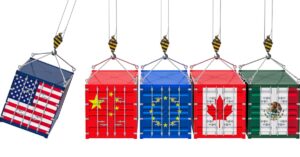The Trump administration’s tariff hikes and oscillating trade policies have created uncertainties for manufacturers, leaving many in limbo without clear direction on what to do. As mixed signals continue to plague the industry, how much these tariffs and trade wars will impact it remains to be seen.
Meanwhile, ocean freight rates and container prices continue to skyrocket, leaving global supply chains increasingly facing the prospect of massive disruption. The on-and-off trade levies keep them in a state of constant confusion.
Continue reading to learn more about what is happening across the freight world.
Uncertainty Forces Manufacturers to Rethink Supply Chains
Manufacturers are growing increasingly uncertain about their supply chain operations following President Trump’s recent tariff action, including a 25% tax on Canadian steel imports. Some believe these tariffs are a short-term tactic, but others worry they could be a long-term shift that forces major changes in global supply chains.
Small and midsize manufacturers, in particular, are in a pickle because they lack the flexibility of larger firms to adapt quickly to rising costs. Tariffs also push companies to seek new suppliers, but this shift is becoming harder as tariffs expand globally. Meanwhile, trade groups are pleading for stability to help protect U.S. exports. Domestic options are also more expensive and could exacerbate labor shortages.
Policy Fluctuations Disrupt Supply Chains and Ocean Freight Rates
President Trump’s shifting tariff policies are causing widespread confusion and disruption for global supply chains. For example, the 25% tariffs on steel imports from Canada had businesses and manufacturers scrambling for a solution, only for the levies to be partially suspended later, causing even more uncertainty. This pattern of adding and removing tariffs is part of broader trade measures aimed at strengthening border security and controlling fentanyl smuggling attempts into the U.S.
The concern around tariffs has affected cross-border shipments from Canada and Mexico, disrupting the flow of goods like electronics and automotive parts. While the uncertainty has forced some companies to front-load ocean shipments, the resulting increases in ocean freight rates are now seeing a trend reversal due to cascading demand and increasing capacity as shipbuilding yards continue delivering new vessels. Ocean container prices have dropped significantly, especially on trans-Pacific routes, and rates for Europe-bound shipments have remained stable.
Tariff Uncertainty Clouds US Trucking Recovery
The U.S. trucking market is slowly recovering from a stubborn downturn, even as economic headwinds make the path unclear. The Trump administration’s recent tariff moves are concerning, as import tariffs disrupt freight planning and lower demand for truckload and LTL carriers.
Shippers facing mixed signals are pulling shipments early to avoid possible future cost hikes, which temporarily boosted freight volumes at the start of the year. Some expect improvements later this year, while others see a delay until 2026. The shifting tariffs also skew data, making it hard to see true trends. With consumer spending cautious and industrial production showing signs of restocking, the market continues to search for its light at the end of the tunnel.
Oversupplied Shipping Market Faces Record Rate Decline
Container shipping is sliding into a tough period. Too many ships and plateauing demand have pushed freight rates below normal seasonal drops. Spot rates on key routes from Asia have fallen by over 50% since January. A large order book and the possibility of a capacity glut with a resolution to the Red Sea crisis add fuel to the fire.
Ongoing tariff disputes and trade tensions continue to cloud the market. This mismatch between supply and demand is expected to lead to losses for several years as carriers struggle to balance their capacity. The industry faces a challenging road ahead until demand picks up and excess capacity is managed.
US Port Imports Expected to Stay High This Spring
According to the latest Global Port Tracker, imports at major U.S. ports are expected to remain strong through the spring but may decline year over year this summer. Retailers are pushing to bring in merchandise before further tariff increases take effect, particularly on Chinese goods, which have seen tariffs rise from 10% to 20%.
Retail sales slightly declined in February, impacted by winter weather and tariff concerns, but they still grew year over year. Additionally, proposed U.S. port tolls on Chinese ships could increase costs, potentially shifting shipping patterns and putting more pressure on larger U.S. ports. Despite the challenges, retailers are working on diversifying supply chains, though significant changes won’t happen immediately.
Seamless Shipments With COGISTICS Transportation
We’re more than an average logistics provider in the market. At COGISTICS Transportation, we pride ourselves on being your end-to-end partner and driving success through collaborative logistics solutions.
With COGISTICS Transportation, complexity becomes clarity, and logistics becomes a competitive advantage. Leveraging over 30 years of expertise, we provide innovative, technology-driven logistics solutions and expedited freight by land, air, and sea — around the clock, around the world. Connect with us today.




